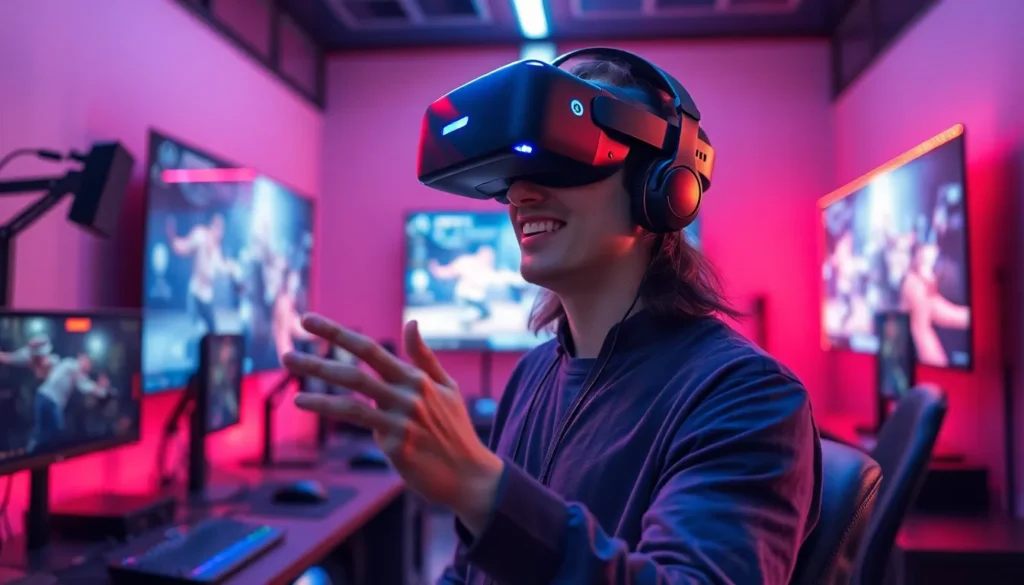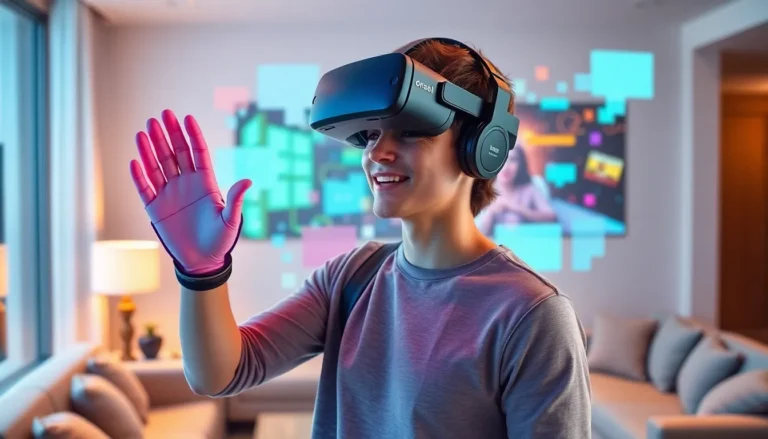Table of Contents
ToggleIn the fast-paced world of virtual reality, staying updated isn’t just a good idea—it’s essential. Imagine strapping on your headset only to find your favorite game has turned into a pixelated time machine. Yikes! VR software updates are the unsung heroes that keep immersive experiences fresh, fun, and free from glitches that could turn your epic battle into a comedy of errors.
These updates are like a digital spa day for your VR system, rejuvenating it with new features, improved performance, and bug fixes. Whether it’s enhancing graphics or adding new content, each update is a chance to dive deeper into worlds that are more vibrant and engaging than ever. So, buckle up as we explore the latest in VR software updates and why they’re vital for every virtual adventurer looking to level up their experience.
Overview of VR Software Updates
VR software updates serve as essential tools for enhancing the overall gaming experience. Regular updates introduce critical enhancements that improve graphics, boost performance, and eliminate bugs. They accommodate new content, refine user interfaces, and sometimes add exciting features that expand functionality.
Gamers often notice significant improvements after installing these updates. Bugs may disrupt gameplay, but timely software fixes ensure a smoother experience moving forward. New graphics enhancements elevate visual immersion, making the virtual world more captivating. Performance upgrades can also reduce latency and increase frame rates, which leads to a more enjoyable and responsive gaming session.
Real-world applications of software updates can vary widely, from small patches that address minor issues to major releases that overhaul system functionalities. For example, a recent update for a popular VR game increased the draw distance and improved texture quality. This update significantly enhanced the players’ ability to immerse themselves in expansive virtual environments.
Feedback from the gaming community often guides these updates. Developers prioritize features based on user reviews and suggestions. User input shapes future updates and influences which bugs are addressed first. Receiving this feedback creates a cycle of continual improvement, ensuring that VR systems remain at the forefront of gaming technology.
Staying informed on the latest VR software updates proves critical for maximizing the virtual experience. Committing to regular checks for updates not only keeps the system running smoothly but also enhances gameplay in ways that significantly impact enjoyment.
Importance of Keeping VR Software Updated

Staying updated with VR software is crucial for an optimal virtual experience. Regular updates significantly enhance gameplay and performance by addressing various issues.
Enhanced Performance
Updates often lead to improved performance metrics. Developers release patches that reduce latency and increase frame rates. Gamers notice smoother movements and quicker responses after applying updates. Performance optimization allows for more immersive gameplay scenarios. For instance, a well-known VR game experienced a boost in responsiveness, directly linked to a recent performance upgrade. Enhanced graphics and refined controls contribute to the overall enjoyment and engagement levels in VR environments.
Security Improvements
Security aspects also benefit from regular software updates. Developers frequently address vulnerabilities that could compromise user data or system integrity. Implementing these updates fortifies the VR environment against potential threats. Users’ privacy and safety become a priority with every patch released. In some cases, community feedback highlights specific security concerns, prompting swift action from developers. Ensuring updated software builds a safer gaming atmosphere, allowing players to enjoy their experience without worries.
Key Features in Recent VR Software Updates
Recent VR software updates introduce various enhancements that significantly improve user experience. Optimizing these updates is crucial for maintaining an engaging gaming environment.
User Interface Enhancements
User interface enhancements simplify navigation and improve overall interaction. Streamlined menus enable quicker access to options, making it easier for gamers to configure settings. Additionally, visually appealing designs and intuitive layouts enhance readability. Developers often prioritize user feedback to identify areas needing improvement. Gamers appreciate features like customizable HUDs that allow for tailored experiences.
New Features and Capabilities
New features and capabilities expand gameplay possibilities and enhance immersion. Recent updates often introduce innovative mechanics that enrich interactions within virtual worlds. For instance, multiplayer functionalities allow players to connect seamlessly with friends. Moreover, enhanced tracking features improve motion accuracy, leading to more responsive gameplay. Developers frequently incorporate user suggestions, ensuring that updates align with community desires. Regular inclusion of fresh content keeps experiences dynamic and engaging.
Challenges Faced During Updates
VR software updates bring critical enhancements but entail several challenges. Gamers frequently encounter issues that can hinder the updating process.
Compatibility Issues
Compatibility issues often arise during VR software updates. Newer updates may not support older hardware or software versions. For instance, a recent updatefor a popular VR headset created problems for users with outdated graphics cards, leading to frustration. Developers strive to accommodate various systems, but disparities in technology can affect users’ ability to enjoy new features. Ensuring systems are compatible requires thoughtful planning and testing across diverse setups. As more gamers upgrade their equipment, resolving compatibility concerns becomes increasingly important for a seamless experience.
User Resistance
User resistance emerges as a notable challenge for software updates. Many gamers prefer their familiar settings and may feel uncertain about new changes. For example, a major update that revamped the interface faced backlash from longtime users who found the new design confusing. Developers often rely on feedback but struggle when users resist adopting these updates. Highlighting the benefits of new features can alleviate some concerns, yet developers must balance innovation with user expectations. Continually communicating the advantages of updates plays a vital role in overcoming resistance and encouraging adoption.
Future Trends in VR Software Updates
Advancements in virtual reality software updates focus on enhancing user experiences. Developers are incorporating artificial intelligence to personalize gameplay based on player behavior. This shift allows adaptive difficulty levels, creating a more tailored gaming environment.
Moreover, cross-platform compatibility is becoming crucial. Game designers strive to ensure that updates function seamlessly across various VR devices to maximize user engagement. Compatibility reduces frustration, allowing players to enjoy new features without hardware limitations.
In addition to performance improvements, security features are evolving. As cyber threats increase, developers prioritize security updates that protect user data. Enhanced encryption methods and user authentication processes provide a safer gaming experience.
Augmented reality integration also influences VR software updates. By merging these technologies, updates often introduce hybrid experiences. Players benefit from immersive elements that blend virtual and physical worlds, enriching gameplay.
User community feedback continues to play a significant role in shaping updates. Developers frequently analyze player suggestions and reviews to prioritize desired features. This approach fosters a sense of community, as players feel their input directly influences future enhancements.
Finally, the incorporation of cloud-based solutions is on the rise. Streamlined updates allow users to access new features directly from the cloud, reducing download times. This innovation not only enhances accessibility but also keeps users engaged with the latest content.
Staying current with VR software updates is essential for maximizing the gaming experience. These updates not only enhance performance and graphics but also address critical security concerns. By incorporating user feedback, developers ensure that each update aligns with community needs and preferences.
As VR technology continues to evolve, embracing these updates will lead to richer and more immersive gameplay. The future promises even more exciting advancements, including AI-driven personalization and cross-platform compatibility. Gamers who prioritize software updates will undoubtedly enjoy a more dynamic and engaging virtual reality experience.







